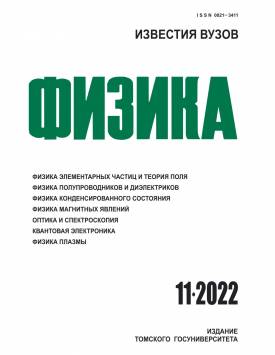Low-current discharge in a flow of argon at atmospheric pressure under the formation of metal atoms: electric and optical characteristics
The paper presents the results of a study of the current-voltage characteristics and optical emission spectra of plasma of a atmospheric pressure pulsed discharge plasma at a frequency of several tens of kilohertz and a pulse duration of up to 10 μs, in the mode of generation of plasma flows containing metal particles. The features of the plasma generator conclude in combination of the design of electrodes, as well as the modes of electric and gas supply of the discharge system. The cathode is a crucible containing a melting insert which allows the discharge operation in a low-current form with a current of 40 mA to 1 A, at a sufficiently high voltage of 150 to 200 V, without transition to arc discharge mode. Such parameters make it possible to generate atomic flows of a melting cathode insert, which are blown out by a jet of working argon gas, pumped at a flow rate of 1 l/min, outside the discharge system. The entry of a metal component into a gas-discharge plasma affects the parameters of the discharge operation, as well as the properties of its optical emission. In the context of this phenomenon, the spectral distributions of the intensity of optical radiation corresponding to the lines of magnesium, indium, and zinc were investigated, as well as their time dependence during the current pulse period operation, in relation to the identification of physical features leading to stable generation of flows of metal atoms at atmospheric pressure.
Keywords
atmospheric pressure discharge, gas-discharge plasma, metal atoms, metal ions, optical spectroscopy, nanoparticlesAuthors
| Name | Organization | |
| Beloplotov D.V. | Institute of High Current Electronics SB RAS | rff.qep.bdim@gmail.com |
| Bugaev A.S. | Institute of High Current Electronics SB RAS | bugaev@opee.hcei.tsc.ru |
| Gushenets V.I. | Institute of High Current Electronics SB RAS | gvi@opee.hcei.tsc.ru |
| Nikolaev A.G. | Institute of High Current Electronics SB RAS | nik@opee.hcei.tsc.ru |
| Nikonenko A.V. | Institute of High Current Electronics SB RAS; Tomsk State University of Control Systems and Radioelectronics | aliska-nik@mail.ru |
| Savkin K.P. | Institute of High Current Electronics SB RAS | savkin@opee.hcei.tsc.ru |
| Sorokin D.A. | Institute of High Current Electronics SB RAS; National Research Tomsk State University | sdma-70@loi.hcei.tsc.ru |
| Cherkasov A.A. | Institute of High Current Electronics SB RAS | cherkasov@opee.hcei.tsc.ru |
| Shandrikov M.V. | Institute of High Current Electronics SB RAS | shandrikov@opee.hcei.tsc.ru |
References
